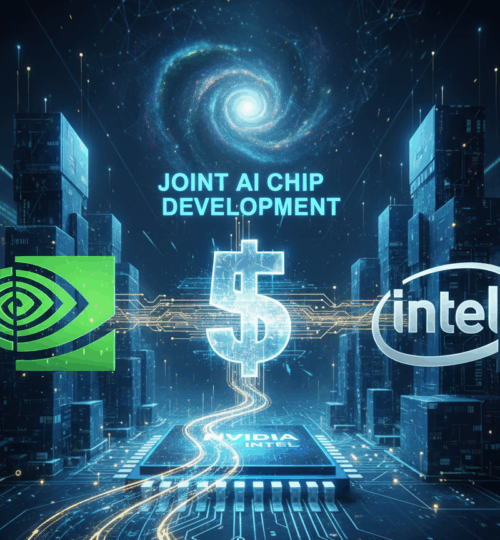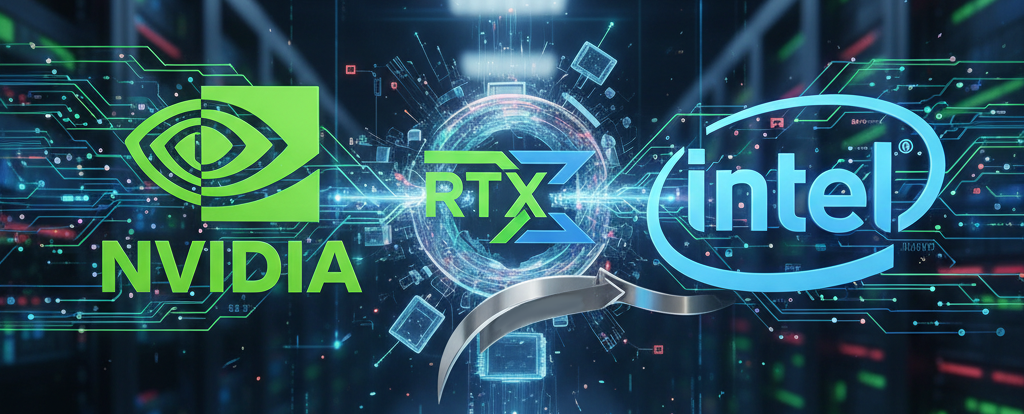The technology industry was sent into a frenzy with the announcement of Nvidia’s unprecedented $5 billion investment in Intel, marking a strategic partnership that will integrate Nvidia’s RTX graphics chiplets directly into Intel’s consumer and AI processors. This collaboration represents one of the most significant shifts in the semiconductor landscape in decades, fundamentally altering the competitive dynamics that have defined the graphics and processing market for years.
The Strategic Motivations Behind the Partnership
Intel’s Perspective: A Lifeline for Arc Graphics
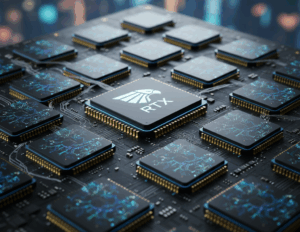 Intel’s motivation for this partnership stems from the harsh realities of competing in the modern graphics market. The company’s Arc graphics division, launched with considerable fanfare and investment, has struggled to gain meaningful market share against the entrenched dominance of Nvidia and AMD. Despite years of development and substantial financial investment, Arc graphics cards have failed to resonate with consumers, plagued by driver issues, performance inconsistencies, and a lack of compelling value propositions.
Intel’s motivation for this partnership stems from the harsh realities of competing in the modern graphics market. The company’s Arc graphics division, launched with considerable fanfare and investment, has struggled to gain meaningful market share against the entrenched dominance of Nvidia and AMD. Despite years of development and substantial financial investment, Arc graphics cards have failed to resonate with consumers, plagued by driver issues, performance inconsistencies, and a lack of compelling value propositions.
By partnering with Nvidia, Intel effectively acknowledges that building a competitive standalone graphics architecture from scratch is extraordinarily challenging in today’s market. The partnership allows Intel to leverage Nvidia’s proven RTX technology while maintaining its position in the processor market. This strategic pivot enables Intel to offer integrated graphics solutions that can compete with AMD’s APU offerings while potentially surpassing them in performance.
From a manufacturing perspective, Intel gains access to Nvidia’s cutting-edge graphics IP without having to continue the expensive and uncertain development of its own graphics architecture. The company can redirect resources previously allocated to Arc development toward other strategic initiatives, such as advancing its CPU architectures or expanding its foundry services.
Nvidia’s Strategic Play: Market Expansion and Risk Mitigation
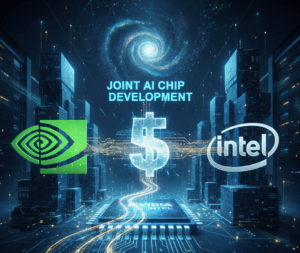 For Nvidia, this partnership represents a masterful expansion strategy that addresses several key business objectives. First and foremost, it provides Nvidia with a guaranteed, high-volume customer for its chiplet technology, ensuring steady revenue streams beyond the volatile gaming and AI markets. By integrating RTX chiplets into Intel processors, Nvidia effectively places its technology into millions of devices that might never have housed discrete Nvidia graphics cards.
For Nvidia, this partnership represents a masterful expansion strategy that addresses several key business objectives. First and foremost, it provides Nvidia with a guaranteed, high-volume customer for its chiplet technology, ensuring steady revenue streams beyond the volatile gaming and AI markets. By integrating RTX chiplets into Intel processors, Nvidia effectively places its technology into millions of devices that might never have housed discrete Nvidia graphics cards.
The partnership also serves as a hedge against potential market disruptions. As the AI boom eventually stabilizes and competition in discrete graphics intensifies, having RTX technology embedded in a significant portion of consumer processors provides Nvidia with a more stable, diversified revenue base. Additionally, this move strengthens Nvidia’s position against AMD, which has been gaining ground with its integrated graphics solutions in processors.
Perhaps most importantly, the partnership positions Nvidia to benefit from the growing trend toward heterogeneous computing, where specialized processors handle different types of workloads. By embedding RTX chiplets in Intel processors, Nvidia ensures its architecture remains relevant as computing moves away from traditional discrete graphics cards toward more integrated solutions.
Community Concerns: The Specter of Graphics Monopolization
The technology community’s reaction to this partnership has been mixed, with significant concerns about the potential for market monopolization. Many enthusiasts and industry observers worry that this alliance could further consolidate Nvidia’s already dominant position in the graphics market, potentially stifling competition and innovation.
Monopoly Fears and Market Concentration
The primary concern revolves around Nvidia’s growing influence across multiple segments of the computing industry. With this partnership, Nvidia’s technology would be present not only in discrete graphics cards, where it already holds a commanding market share, but also in integrated solutions through Intel processors. This level of market penetration raises questions about whether meaningful competition can survive.
Critics argue that this partnership effectively eliminates Intel as a potential competitor in the graphics space, reducing the market to essentially two players: Nvidia and AMD. This consolidation could lead to reduced innovation, higher prices, and fewer choices for consumers. The concern is particularly acute given Nvidia’s recent dominance in the AI market, where its GPUs have become essential infrastructure for machine learning and artificial intelligence applications.
Regulatory and Antitrust Implications
 The partnership is likely to attract scrutiny from regulatory bodies worldwide, particularly given the current focus on technology market concentration. Antitrust authorities may examine whether this alliance creates barriers to entry for potential competitors or gives Nvidia unfair advantages in emerging markets like edge computing and mobile graphics.
The partnership is likely to attract scrutiny from regulatory bodies worldwide, particularly given the current focus on technology market concentration. Antitrust authorities may examine whether this alliance creates barriers to entry for potential competitors or gives Nvidia unfair advantages in emerging markets like edge computing and mobile graphics.
The integration of RTX chiplets into Intel processors could also raise concerns about proprietary technology lock-in, where consumers and manufacturers become dependent on Nvidia’s ecosystem in ways that make it difficult to switch to alternative solutions.
Potential Benefits and Strategic Advantages
Despite the concerns, the partnership offers several potential benefits that could advance the overall state of graphics computing. The integration of RTX chiplets into Intel processors could lead to significant improvements in integrated graphics performance, bringing capabilities previously reserved for discrete graphics cards to a much broader range of devices.
This advancement could democratize access to high-quality graphics processing, enabling better gaming experiences, content creation capabilities, and AI acceleration in mainstream devices. The partnership might also drive innovation in chiplet design and integration, potentially leading to more efficient and powerful computing solutions.
From a manufacturing efficiency perspective, the collaboration could reduce redundancy in research and development spending, allowing both companies to focus on their core competencies while delivering better products to consumers.
Gaming Community Impact: Analyzing the Pros and Cons
The Limited Upside for Gamers
Any instinct about the limited benefits for gamers appears to be well-founded. The most significant potential advantage would be improved integrated graphics performance in Intel processors, which could benefit casual gamers or those using laptops and budget systems. Integrated RTX chiplets could bring ray tracing and DLSS capabilities to devices that previously couldn’t support these features, potentially expanding the market for games that utilize these technologies.
The partnership might also lead to better optimization between Intel CPUs and Nvidia graphics technology, potentially resulting in slight performance improvements in gaming scenarios. Additionally, the increased volume production of RTX chiplets could theoretically lead to some cost efficiencies that might eventually benefit discrete graphics card pricing.
The Concerning Downsides
 However, the disadvantages for the gaming community appear to significantly outweigh these modest benefits. The most immediate concern is the potential reduction in competition, which historically has been the primary driver of both performance improvements and price reductions in graphics technology. With Intel effectively removed from the discrete graphics competition, AMD becomes Nvidia’s only serious rival, potentially leading to less aggressive pricing and slower innovation cycles.
However, the disadvantages for the gaming community appear to significantly outweigh these modest benefits. The most immediate concern is the potential reduction in competition, which historically has been the primary driver of both performance improvements and price reductions in graphics technology. With Intel effectively removed from the discrete graphics competition, AMD becomes Nvidia’s only serious rival, potentially leading to less aggressive pricing and slower innovation cycles.
The partnership could also result in increased prices for discrete graphics cards, as Nvidia may have less incentive to compete aggressively on price when it has guaranteed revenue from integrated chiplet sales. This situation could be particularly problematic for high-end gaming, where discrete graphics cards remain essential for optimal performance.
Furthermore, the integration of RTX chiplets into Intel processors might create artificial market segmentation, where certain features or performance levels are only available through specific hardware combinations. This could limit consumer choice and potentially increase the overall cost of building gaming systems.
Long-term Industry Implications
The Nvidia-Intel partnership represents more than just a business deal; it signals a fundamental shift in how the semiconductor industry approaches graphics computing. The move toward chiplet integration reflects broader industry trends toward specialized computing architectures and heterogeneous processing solutions.
This partnership could accelerate the decline of traditional discrete graphics cards for mainstream applications, with integrated solutions becoming powerful enough for most users’ needs. While this evolution might benefit general computing applications, it could create challenges for the enthusiast gaming market, where discrete, upgradeable graphics cards have long been the standard.
The alliance also highlights the increasing complexity of modern semiconductor development, where even major corporations like Intel find it more practical to partner with competitors rather than develop competing technologies independently. This trend could reshape the entire industry, leading to more collaborative but potentially less competitive market dynamics.
A Pivotal Moment for Graphics Computing
The $5 billion Nvidia-Intel partnership represents a watershed moment in graphics computing, with implications that extend far beyond the immediate business benefits for both companies. While the alliance offers potential advantages in terms of integrated graphics performance and manufacturing efficiency, it also raises serious concerns about market concentration and competitive dynamics.
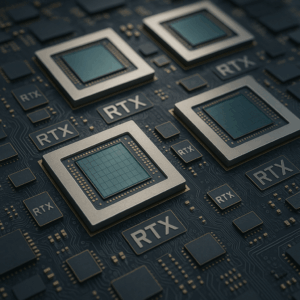 For gamers, the partnership appears to offer limited immediate benefits while potentially creating long-term disadvantages through reduced competition and market consolidation. The technology community’s concerns about monopolization appear well-founded, given the partnership’s potential to further strengthen Nvidia’s already dominant market position.
For gamers, the partnership appears to offer limited immediate benefits while potentially creating long-term disadvantages through reduced competition and market consolidation. The technology community’s concerns about monopolization appear well-founded, given the partnership’s potential to further strengthen Nvidia’s already dominant market position.
As this partnership develops, the industry will be watching closely to see whether the promised innovations and efficiencies materialize, and whether regulatory authorities take action to address competitive concerns. The ultimate impact of this alliance will likely be determined not just by the technical capabilities it enables, but by how it shapes the competitive landscape for graphics computing in the years to come.
The gaming community, in particular, should remain vigilant about how this partnership affects pricing, innovation, and choice in the graphics market, as the long-term health of the gaming ecosystem depends on maintaining robust competition among graphics technology providers.

